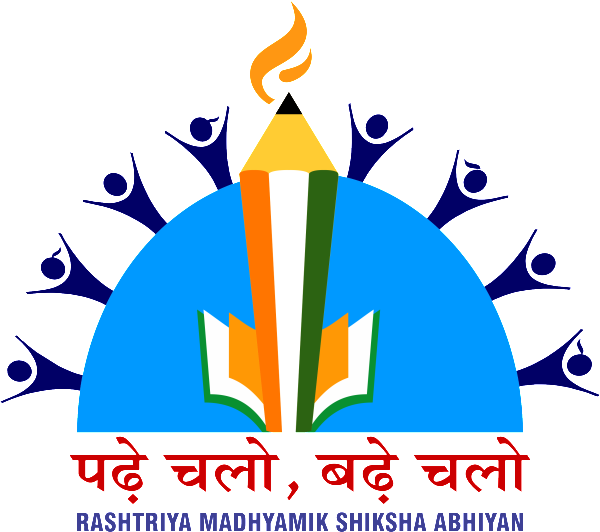The IEDSS (Inclusive Education of the Disabled at the Secondary Stage) scheme launched in the year 2009 focuses on children with disability at secondary stage of their education i.e. from the IX to XII. The scheme has been merged with RMSA (Rashtriya Madhyamik Shiksha Abhiyan) and aims at enabling children with disability, along with other children in need, to pursue secondary education, post the completion of elementary education. The scheme covers all children studying at the secondary stage in Government, local body and Government-aided schools, with one or more disabilities as defined under the Persons with Disabilities Act (1995) and the National Trust Act (1999) in class IX to XII. The goal of the scheme is to increase the gross enrolment ratio by providing accessibility in terms of a secondary school within reasonable distance, quality of education and removal of social and economic barrier within 5 years (2013-2017)
Implementation of Scheme:
RMSA approved 10513 new secondary schools, out of which, 9239 new secondary schools have been made functional. The existing 35539 schools have been approved of strengthening 24581 new science labs, 30761 art/craft/culture rooms, 19510 toilet blocks, 12275 drinking water facilities and 2130 residential quarters. Out of these 7315 science labs, 5324 computer rooms, 7406 libraries, 7959 art/craft/culture rooms, 5975 toilet blocks, 4255 drinking water facility and 441 residential quarters have been completed. 51750 additional classrooms have been approved, out of which 14644 have been completed and 12562 are in progress. With regard to teachers, 107480 teachers (including 41507 additional teachers) have been sanctioned for secondary schools. Out of which 59353 teachers have been appointed.
Inclusion under the scheme:
The framework of the RMSA provides for various measures including intensive micro-planning to provide flexibility to develop context-specific interventions, reduction of educational inequalities by giving priority to the children in need areas and population sectors, regular enrolment drives, special camp and bridges courses, open and distance learning, providing hostel facilities, monitoring attendance in pockets identified for intensive activities, special coaching classes/remedial classes especially for educationally minority girls and children who are not doing academically well, teacher sensitization programme, etc. for ensuring access to these groups..
Improvement of quality of education:
With a view to enhance quality of secondary education in the Government secondary schools, the scheme provides for Additional Teachers to improve PTR, Teachers, Headmasters and staff for new secondary school, In-service training for principals, teachers (since State Governments support grant in aid schools mostly for salary of the teachers, in-service training of teachers is provided under RMSA for Grant in aid schools for their capacity building), Leadership and Professional development programme of headmasters, Excursion trip for Teachers, Providing of Math Lab kits, Science Lab kits, Excursion trip for students of classes IX or X, Remedial teaching (bridge courses), enhancement of learning achievement for poor students, Providing lab assistant and clerk. 105722 teachers (include 41507 additional teachers) have been sanctioned for secondary schools, out of which 46120 teachers have been appointed.
Analysis:
The global EFA (Education for All) initiative provided an added impetus to the programmes for achieving the goal of Education for All in India. The Gross Enrolment Ratios in primary (Classes I-V; age 6-10 years) and upper primary education (Classes VI-VII; age 11-13 years) during 2000-01 were 95.7 % and 58.6 % respectively. The gender gaps in GERs at the primary and upper primary levels respectively were 19 percentage points and 16.8 percentage points during 2000-01. The Gross Enrolment Ratio in secondary/ higher secondary education (Classes IX-XII; age 14-17 years) was only 33.7 %. The overall drop-out rates in Classes I-V, Classes I-VIII) and Classes I-X were 40.7 %, 53.7 % and 68.6 % respectively.
The lower NERs at upper primary (64.2 % in 2013-14) and secondary level (41.9 %) are a matter of great concern. One of the priority tasks in the context of EFA goals is achieving further progress towards universal enrolment and retention of enrolled children at the upper primary and secondary stages of education. Drop-out rates in elementary and secondary education: The XIth FYP (Five Year Plans) had targeted a reduction in dropout rates from 50 % to 20 % at the elementary stage. Even though the drop-out rates at elementary and secondary stages of education have been declining, the progress has not been satisfactory. The low NER (Net Enrolment Ratio) at the upper primary level and the increasing enrolment gap from elementary to secondary level suggests that although a larger number of children are entering the educational system, a significant proportion of them are not progressing through the system to complete elementary/secondary cycle of education. Though the drop-out rate is a matter of concern in the case of all categories of students, drop-out rates among disadvantaged groups, especially for girls from these groups, remain higher than the national average. This brings into focus the need to undertake measures to improve retention in schools of children from socially and economically disadvantaged communities.
Children with special needs constituted a significant proportion of OoSC (Out of School Children) in 2009. It was found that children with disabilities constituted about 34.2 % of OoSC in 2009. The maximum number of OoSC belonged to those with mental disabilities (48 %), followed by children with speech disabilities (37 %). This situation highlights the needs to equip the schools to address the challenging needs of mentally challenged children who are both socially and educationally disadvantaged.
References:

